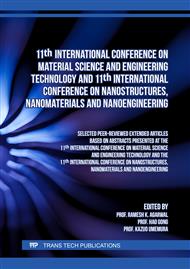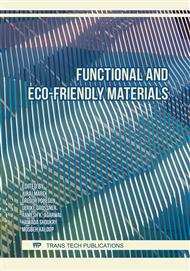p.67
p.71
p.77
p.83
p.93
p.101
p.109
p.117
p.129
Properties of Geopolymer Mortar Mixtures Containing Waste Glass Aggregates and River Sand
Abstract:
This paper evaluates the properties of fly ash (FA) and ground granulated blast furnace slag (GGBFS) based geopolymer mortar mixtures with waste glass sand (WGS) obtained by crushing glass bottles. A total of seven mixtures, including the partial substitution of river sand (RS) with WGS (0%, 15%, 30%, and 45%) with two alkali activator solution to binder (AAS/b) ratio groups (0.4 and 0.3), were designed. Sodium silicate (Na2SiO3) and sodium hydroxide (NaOH) were used as the alkali activators. The experimental program evaluated compressive strength, hardened density, alkali-silica reaction (ASR), drying shrinkage, and thermal conductivity of geopolymer mortar mixtures. Test results indicated that the compressive strength of the geopolymer mortar increased with the addition of WGS for AAS/b = 0.4, but it had a negative effect for AAS/b = 0.3. The FA and GGBFS-based geopolymer mortar helps to reduce the ASR expansion of the mixture containing WGS. The drying shrinkage of the geopolymer mortar decreases with the increase of the WGS content. The increase of WGS decreases the thermal conductivity of geopolymer mortar in the case of mixtures with AAS/b = 0.4, but interestingly thermal conductivity value increases in the case of mixtures with AAS/b = 0.3. The findings of this study suggest that using WGS as partial RS substitution material in geopolymer mortar offers sufficient mechanical and thermal insulation properties without causing durability issues.
Info:
Periodical:
Pages:
93-99
Citation:
Online since:
May 2023
Price:
Сopyright:
© 2023 Trans Tech Publications Ltd. All Rights Reserved
Share:
Citation:



